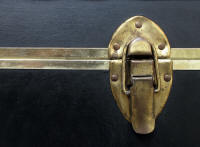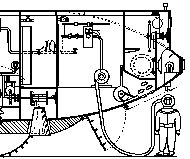|
|
|||||||||
HatchesThe top hatch in an ambient submarine is an important concern. In 1 ATM submarines where the hatch opens outward, the pressure of the water will hold the hatch closed. But if a hatch opens outward on an ambient submarine than the air pressure inside the submarine only wants to push the hatch open. The Jr. is about 5ft tall from keel to the deck, so that's 5ft of water that is pushing to get inside when the bottom hatch is open. Every foot of water adds just under 1/2 pound of force on one square inch or 1/2 psi. So 5 ft of water is 2 1/2 psi. If the hatch is 20 x 20 then it is 400 square inches and with 2 1/2 pounds of force on each square inch that multiplies to 1000 pounds of force pushing the hatch open.
So somehow the hatch needed to be dogged down. If we use 2 latches then it's 500 lbs per latch. Simon Lake might have used "trunk latches" or "draw latches" to keep the hatch shut. In 1894, trunk latches would have been widely available. Today we can order draw latches rated for 1000 pounds from suppliers like Grainger, www.grainger.com for $25 each. Another option that Simon likely considered would have been to just let the hatch open inward and operate the Argonaut Jr as a dry ambient submarine. From the books available he submerged the Argonaut Jr as a 1 ATM submarine and then pressurized the inside with air only before opening the diver's hatch in the bottom. He likely dove Argonaut Jr as a 1 ATM because it was the prototype for Simon's Argonaut I which would be 1 ATM with a diver lock-out compartment. This compartment was pressurized with air before the diver opened the bottom hatch. Since the bottom hatch opened outward, it would have only been possible to open it once the compartment was pressurized. Until then the water pressure outside the submarine would force the hatch closed.
|









